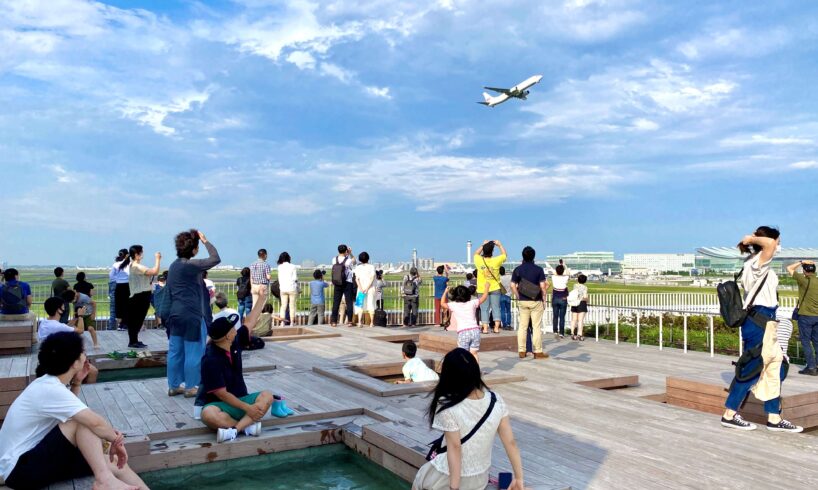
To really get a feel for Tokyo, pick a neighborhood at random and spend the day exploring what lies there. Step away from the usual haunts of Shibuya or Ginza and embrace the possibility of new discoveries. One suggestion: take the train to Tenkubashi Station, literally “sky bridge,” just one stop from Haneda Airport.
Here you arrive at Tokyo’s newest “city” of culture, dining, nightlife and innovation. Haneda Innovation City (HICity) occupies ground that has lived many lives: once a seaside resort, later the site of Japan’s pioneering airport terminal. Today, it’s reimagined as a mixed-use district where residents and travelers cross paths.
Getting there is easy: about 13 minutes from Shinagawa, 21 minutes from Tokyo Station and 15 minutes from Yokohama. Here’s Metropolis’ guide to our favorite things to do in Haneda Innovation City and the history that shaped it.
Courtesy of Haneda Mirai Development Co., Ltd. / Credit: FOTOTECA
Things To Do in Haneda Innovation City
Footbath and Views
The best-known attraction of HICity is the Footbath Sky Deck. When it opened it quickly went viral on Japanese social media: a rooftop hot-spring-style footbath where you can watch planes taking off and landing just beyond the runways.
Entertainment
Beyond the rooftop, the district holds one of Tokyo’s largest concert halls, Zepp Haneda (Tokyo), which can host around 3,000 people standing. The Artist Village and the Innovation Corridor, a 200-metre pedestrian spine through the complex, provide stages for installations, performances and seasonal festivals.
For something unexpected, Luxury Flight offers fighter jet simulators imported from abroad, complete with advisors, including former pilots, to guide first-timers. Families or groups can even compete across three simulators at once.
Dining and Local Flavor
HICity brings together neighborhood icons from Ota Ward: Tonkatsu Aoki, known for its thick-cut pork cutlets, and Harukaen, a long-standing Chinese restaurant celebrated for its crispy hanetsuki gyoza and an extensive menu of over 50 dishes. A great way to try out very local institutions gathered in one place.
Gurunavi Foodhall WYE, operated by Japan’s best-known restaurant review platform, curates specialties from across the country. HANEDA SKY BREWING serves “Made in Ota” craft beer alongside seasonal menus that highlight Tokyo-grown produce, while Nomuraya offers yakiniku (Japanese BBQ) with Tochigi beef and local sake.
Stay and Pause
HICity is designed for both day visitors and overnight stays, with two hotels on site. The Hotel Metropolitan Haneda offers comfortable rooms and a rooftop restaurant, Il Cielo, where guests can dine with views across the bay. The Keikyu EX Inn features a large communal bath and a free airport shuttle, ideal for catching an early flight.
Innovation and Research
HICity is more than leisure. It also functions as an innovation hub and is home to offices and laboratories dedicated to fields such as mobility, robotics and medicine.
Operated by Kawasaki Heavy Industries, Future Lab HANEDA serves as a testing ground for robotics designed to address social challenges. It also houses YouComeLab, where startups and research institutions can experiment with some of the most advanced robots currently in development.
Medical research is another pillar. Fujita Medical University operates both a research center, offering advanced health checks and regenerative medicine, and an on-site clinic. The district’s Haneda Tenkubashi Clinic specializes in exosome research. In partnership with E-GiC, it focuses on translating new biomedical technologies and treatments into clinical practice.
Another cornerstone is HANEDA×PiO, a hub that brings together two key elements: a tenant zone for companies pursuing new ventures and social innovation, and PiO PARK, an open space designed to encourage collaboration and exchange. Located on the first and second floors of Zone K, it draws in a wide range of participants from Ota Ward firms and research institutions to domestic and international businesses, universities and startups.
HICity is also home to many innovative companies and their offices. Denso operates its Advanced Mobility Center here, where autonomous driving technologies are researched and tested on an adjoining private road.
History of Haneda and Tenkubashi Area
Before planes, this part of Tokyo was something else entirely. Until the late Edo period, it was little more than mudflats, prone to flooding, until the land was raised and pines were planted in the 1700s. The effort turned it into a place of natural beauty. In 1804, Anamori Inari Shrine was founded to protect the area. Over time, it became linked to aviation safety, a role it still carries today.
Wild Geese at Haneda By Utagawa Hiroshige (Public Domain)
By the mid-19th century, the shrine town was drawing visitors with its shops, restaurants and seaside views, which on clear days stretched as far as the Boso Peninsula. When a sodium spring was discovered in 1896, the area transformed into a resort for Tokyoites, complete with inns, teahouses and a lively entertainment quarter. Popularity grew quickly enough that in 1902, a new railway line linked the district directly to the city.
In 1917, the flat land at the river mouth was chosen for a flight school, beginning Haneda’s association with aviation. A little more than a decade later, in 1929, the site was selected for Japan’s new civilian airport, and in 1931, Haneda Airport officially opened.
The Second World War brought rupture. The airport was seized by American occupation forces and turned into the Haneda Army Airbase. To expand the runways, the U.S. ordered more than 1,300 households to relocate within 12 hours. A desperate negotiation by the Japanese government extended the deadline to 48, but the removals were still traumatic. Families stood across the river and watched as bulldozers erased their homes. Only the great torii of Anamori Inari was left standing, a solitary marker of the community that had been forced out.
By 1953, Japanese airlines, led by JAL, were allowed to resume flights. As Tokyo’s economy recovered, air traffic soared, and Haneda expanded steadily toward the shoreline. The original terminal and its surroundings eventually gave way to today’s Haneda Innovation City. The airport’s first station, once called Haneda Airport, was renamed Tenku-bashi—“sky bridge”—and still serves as the entry point. The shrine’s torii gate, relocated south of the station, remains a short walk from HICity, quietly anchoring the area’s memory.
Haneda Innovation City marks yet another reinvention. No longer a shrine town or a passenger terminal, the site has returned to public life as a district where culture, leisure and technology meet.
Haneda Innovation City
Address:
1-1-4 Hanedakuko, Ota-ku 144-0041
Station:
Tenkubashi Station
(13 minutes from Shinagawa, 21 minutes from Tokyo Station, and 15 minutes from Yokohama)
For more information:
Official Website
【EVENT: October-November 2025】
Japan Night Fever: Haneda Innovation City (Haneda Yorumachi)
Haneda Innovation City will stage “Japan Night Fever (Haneda Yorumachi)” across six evenings in October and November 2025. Japan Night Fever is a night market imagined as a meeting point of cyberpunk aesthetics and centuries-old Japanese motifs. Visitors will walk through a corridor where paper lanterns cast warm shadows, before the scene shifts into neon-lit installations that nod to the futuristic yet retro aesthetics of cyberpunk fiction.
Dates:
October 11th (Saturday)
October 18th (Saturday)
October 31st (Friday)
November 1st (Saturday)
November 2nd (Sunday)
Time:
4pm-10pm (hours may vary depending on the program and are subject to change.)
Learn more about the event:
Cyberpunk Night Market in Tokyo





